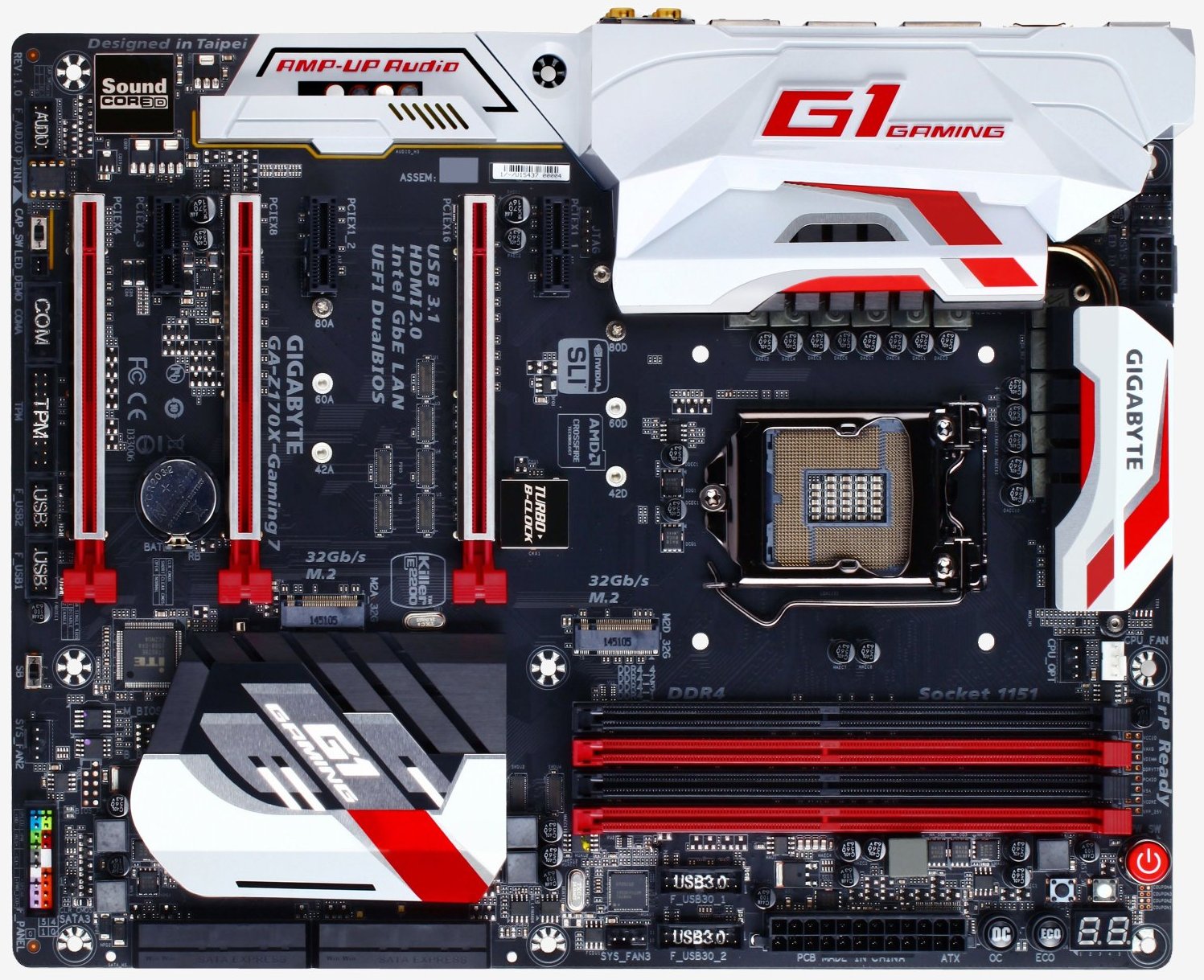Intel Z170 Motherboard Roundup > Gigabyte Z170X-Gaming 7
Gigabyte Z170X-Gaming 7
It has to be said that the Gigabyte Z170X-Gaming 7 looks similar it would cost considerably more than than it does. The Gaming seven is 2d in control, falling in line backside the G1 flagship model, while the Gaming v and Gaming 3 exist below it.
Gigabyte offers a huge range of motherboard product families with their own distinct themes. The G.1 Sniper Z170 for example wears greenish and blackness, the standard boards are now yellow and blackness, while the overclocking models are orange and black.

Now we have the 'Gaming' range which comes in black, red and white. It'southward an interesting range of colors and I am not entirely sure what to brand of it. I guess depending on the residual of your build the white highlights could look absurd.
Moving past the look of the Z170X-Gaming 7 nosotros actually have what is a rather serious motherboard.

The Z170X-Gaming 7 is cheaper than both the Asrock Z170 Extreme7+ and Asus ROG Maximus Eight Hero, though looking at the feature list you wouldn't necessarily believe it.
Onboard you'll find eight SATA 6Gb/s ports, three SATA Express ports, two M.two slots, a Creative SoundCore 3D sound solution, ii Gigabit network controllers, heaps of USB three.0 ports and a few USB 3.1 ports for practiced measure.
The PCI Express slot layout and configuration is exactly the aforementioned as the Maximus 8 Hero which is a good thing. This means 2-style GPUs operate in a x8/x8 configuration, while 3-way runs at x8/x8/x4.

Along with the standard six SATA 6Gb/south ports Gigabyte has too included the ASMedia ASM1061 fleck for an additional two SATA ports.
The Z170X-Gaming seven's M.2 slot configuration is complicated, not but when installing SATA M.ii devices just also when using PCIe M.two devices.
If yous were to install a PCIe x4 SSD in the 2d M.2 slot labeled 'M2H' then SATA0, i, 2 and 3 all get disabled, along with the SATA Express ports that they support. When using a PCIe x2 SSD, only SATA ports 2 and three get disabled.

Information technology should also exist noted that while the ii M.2 slots are each coupled with four lanes of PCIe iii.0 bandwidth, the 2d K.2 slot is linked to the third PCIe x16 (x4 wired) slot. This means either the 3rd PCIe x16 slot can exist used or the M2H M.2 slot with a PCIe SSD.
This seems confusing and we oasis't even discussed SATA-based One thousand.2 SSDs yet. If you install a SATA One thousand.two device in the kickoff slot labeled 'M2D', the 3rd SATA port is disabled. If you install a SATA One thousand.two device in the 2nd M.2 slot and then SATA port zero is disabled.
So, while the Gigabyte Z170X-Gaming 7 offers 13 storage interfaces in total, only a maximum of 8 tin can exist used at any once.

Of all the boards tested, the Z170X-Gaming vii is the only non to use the Realtek ALC1150, instead Gigabyte has gone for something a piffling more high-end. Its sound solution has been branded SoundCore 3D and at its centre is the Creative CA0132 audio chip. Armed with a quad-core audio processor, the dedicated audio processor is used to offload work from the CPU.

The Creative CA0132 runs analog audio through an upgradable op-amp that drives the gold-plated rear audio jacks. An on-lath switch adjacent to the op-amp selects betwixt a 2.5x or a 6x audio gain and this can be useful for high-impedance speakers or headphones, and once once more we find audio capacitors from Nichicon.
Networking is double teamed by the Intel I219-V and Killer E2400, which ironically ways teaming is out of the question. While I practice like to have dual Intel controllers for teaming, I understand this is a characteristic most users purchasing the Z170X-Gaming 7 won't crave.

For those that buy into the placebo effect of lag free gaming with the Killer E2400, so I guess that will be a welcomed addition, though I doubtable it will exist more useful for selling the Z170X-Gaming 7 to the unsuspecting consumer. In any instance, it's overnice to find dual Gigabit LAN controllers on the Z170X-Gaming 7.
The Z170X-Gaming 7 is USB three.0 rich, though there are just five ports on the I/O console with a further four available via on-board headers. Complementing the USB three.0 support on the I/O panel is a pair of USB 3.1 ports which includes a Type-A port and Type-C port.

Speaking of the I/O panel, autonomously from the USB 3.0 and 3.i ports in that location is a PS/2 port, DisplayPort, HDMI output, dual Gigabit LAN ports, five audio jacks and an optical audio output. At that place is a complete lack of legacy USB two.0 ports, which we don't accept an issue with.
Gigabyte'due south EasyTune software has been given a complete makeover for their Z170 motherboards and we have to say this latest version is great with its clean white appearance. The functionality is slap-up and users can enjoy quick and hassle gratis automobile overclocking while in that location are loads of advanced overclocking options too.
All the fan monitoring and controls accept been moved to a separate awarding called Organization Information Viewer and we quite like having all this separate.
We likewise found another handy petty application called 3D OSD which is designed equally a quick and easy way to monitor the organisation in real-time.
Finally, the Z170X-Gaming 7 UEFI is features a classic BIOS look with none of the fancy features of its competitors.
Source: https://www.techspot.com/review/1073-intel-z170-motherboard-roundup/page6.html
Posted by: bennerjusible.blogspot.com


0 Response to "Intel Z170 Motherboard Roundup > Gigabyte Z170X-Gaming 7"
Post a Comment